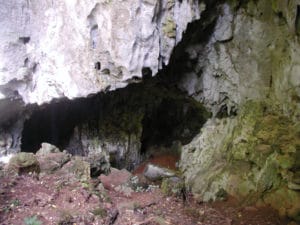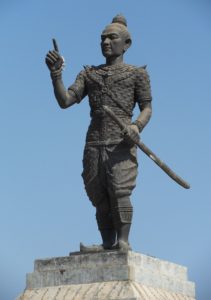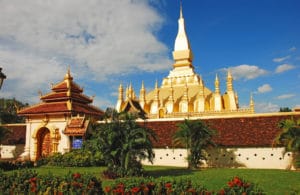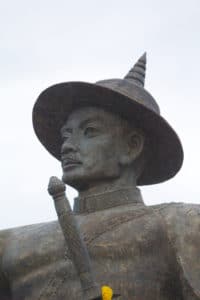
Stone artifacts including Hoabinhian types have been found at sites dating to the Late Pleistocene in northern Laos. Archaeological evidence suggests an agriculturist society developed during the 4th millennium BC. Burial jars and other kinds of sepulchers suggest a complex society in which bronze objects appeared around 1500 BC, and iron tools were known from 700 BC. The proto-historic period is characterized by contact with Chinese and Indian civilizations. According to linguistic and other historical evidence, Tai-speaking tribes migrated southwestward to the modern territories of Laos and Thailand from Guangxi sometime between the 8th–10th centuries.
Lan Xang:
Laos traces its history to the kingdom of Lan Xang (‘million elephants’), which was founded in the 14th century by a Lao prince, Fa Ngum, whose father had his family exiled from the Khmer Empire.

Fa Ngum, with 10,000 Khmer troops, conquered many Lao principalities in the Mekong River Basin, culminating in the capture of Vientiane. Ngum was descended from a long line of Lao kings that traced back to Khoun Boulom. He made Theravada Buddhism the state religion and Lan Xang prospered. Within 20 years of its formation, the kingdom expanded eastward to Champa and along the Annamite mountains in Vietnam. His ministers, unable to tolerate his ruthlessness, forced him into exile to the present-day Thai province of Nan in 1373, where he died. Fa Ngum’s eldest son, Oun Heuan, ascended to the throne under the name Samsenthai and reigned for 43 years. Lan Xang became an important trade center during Samsenthai’s reign, but after his death in 1421 it collapsed into warring factions for nearly a century.
In 1520, Photisarath came to the throne and moved the capital from Luang Prabang to Vientiane to avoid a Burmese invasion. Settathirath became king in 1548, after his father was killed, and ordered the construction of what became the symbol of Laos, That Luang.

Settathirath disappeared in the mountains on his way back from a military expedition into Cambodia and Lan Xang fell into more than seventy years of instability, involving both Burmese invasion and civil war.
It was not until 1637, when Sourigna Vongsa ascended the throne, that Lan Xang further expanded its frontiers. His reign is often regarded as Laos’s golden age. When he died without an heir, the kingdom split into three principalities. Between 1763 and 1769, Burmese armies overran northern Laos and annexed Luang Phrabang, while Champasak eventually came under Siamese suzerainty.
Chao Anouvong was installed as a vassal king of Vientiane by the Siamese.

He encouraged a renaissance of Lao fine arts and literature and improved relations with Luang Phrabang. Under Vietnamese pressure, he rebelled against the Siamese in 1826. The rebellion failed and Vientiane was ransacked. Anouvong was taken to Bangkok as a prisoner, where he died.
A Siamese military campaign in Laos in 1876 was described by a British observer as having been “transformed into slave-hunting raids on a large scale”.
French Laos (1893–1953):
In the late-19th century, Luang Prabang was ransacked by the Chinese Black Flag Army. France rescued King Oun Kham and added Luang Phrabang to the Protectorate of French Indochina. Shortly after, the Kingdom of Champasak and the territory of Vientiane were added to the protectorate. King Sisavang Vong of Luang Phrabang became ruler of a unified Laos and Vientiane once again became the capital.
